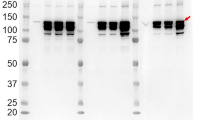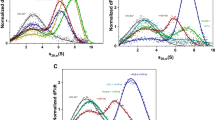Summary
The investigation on hydrodynamic parameters of molybdate-stabilized glucocorticoid-receptor complexes from HeLa cell cytosol permitted resolution of four distinct forms. The first one could be detected in concentrated cytosols at low salt concentrations, and had the following properties: sedimentation coefficient = 9 S; R s = 9.3 nm; M r = 357,800; f/f o = 1.83; axial ratio (prolate ellipsoid) = 16. When these cytosol extracts were diluted, a second form could be detected with sedimentation coefficient = 8.3 S; R s = 9.05 nm; M r = 320,700;f/f o = 1.84; axial ratio = 16. Under high salt conditions, glucocorticoid-receptor complexes in concentrated cytosol had the following properties: sedimentation coefficient = 6.4 S; R s, = 6.7 nm; M r = 183,100;f/f o = 1.64; axial ratio = 12. When either these cytosol extracts were diluted, or glucocorticoid-receptor complexes were subjected to repeated analysis, a fourth form was detected with sedimentation coefficient = 3.76 S; R s = 5.67; M r = 91,000; f/f o = 1.75; axial ratio = 14. Besides salt concentration and dilution, the time elapsed between sample dilution and analysis appeared to affect the hydrodynamic properties of glucocorticoid-receptor complexes. On the basis of our findings, it has been concluded that the most likely structure of molybdate-stabilized glucocorticoid-receptor complexes of HeLa cell cytosol can be represented by association of monomers in homodimers, and homotetramers. A homotrimer form could not be deduced from our findings, and the 320,700 glucocorticoid-receptor complex we observed has been suggested to represent an unresolved mixture of trimers and tetramers.
Similar content being viewed by others
References
Sherman MR, Stevens J: Structure of mammalian steroid receptors: Evolving concepts and methodological developments. Ann Rev Physiol 46:83–105, 1984.
Raaka BM, Samuels HH: The glucocorticoid receptor in GH1 cells. J Biol Chem 258:417–425, 1983.
Vedeckis WV: Subunit dissociation as a possible mechanism of glucocorticoid receptor activation. Biochemistry 22: 1983–1989, 1983.
Sherman MR, Moran MC, Tuazon FB, Stevens Y-W: Structure, dissociation, and proteolysis of mammalian steroid receptors. J Biol Chem 258:10366–10377, 1983.
Holbrook NJ, Bodwell JE, Jeffries M, Munck A: Characterization of nonactivated and activated glucocorticoid-receptor complexes from intact rat thymus cells. J Biol Chem 258:6477–6485, 1983.
Currie RA, Cidlowski JA: Physicochemical properties of the cytoplasmic glucocorticoid receptor complex in HeLa S3 cells. J Steroid Biochem 16:419–428, 1982.
Rossini GP: RNase A effects on sedimentation and DNA binding properties of dexamethasone-receptor complexes from HeLa cell cytosol. J Steroid Biochem 22: 47–56, 1985.
Horwitz KB, McGuire WL: Nuclear estrogen receptors. J Biol Chem 255:9699–9705, 1980.
Sherman MR, Tuazon FB, Miller LK: Estrogen receptor cleavage and plasminogen activation by enzymes in human breast tumor cytosol. Endocrinology 106:1715–1727, 1980.
Martin RG, Ames BN: A method for determining the sedimentation behavior of enzymes: Application to protein mixtures. J Biol Chem 236:1372–1379, 1961.
Siegel LM, Monty KJ: Determination of molecular weights and frictional ratios of proteins in impure systems by use of gel filtration and density gradient centrifugation. Application to crude preparations of sulfite and hydroxylamine reductases. Biochim Biophys Acta 112:346–362, 1966.
Sherman MR: Physical-chemical analysis of steroid hormone receptors. Meth Enzymol 36:211–234, 1975.
Schachman HK: Ultracentrifugation in Biochemistry. Academic Press, New York, 1959, p 239.
Liao S, Smythe S, Tymoczko JL, Rossini GP, Chen C, Hiipakka RA: RNA-dependent release of androgen- and other steroid-receptor complexes from DNA. J Biol Chem 255:5545–5551, 1980.
Lowry OH, Rosebrough NJ, Farr AL, Randall RJ: Protein measurement with the Folin phenol reagent. J Biol Chem 193:265–275, 1951.
Sherman MR, Pickering LA, Rollwagen FM, Miller LK: Mero-receptors: Proteolytic fragments of receptors containing the steroid-binding site. Fed Proc 37:167–173, 1978.
Vedeckis WV: Limited proteolysis of the mouse liver glucocorticoid receptor. Biochemistry 22:1975–1983, 1983.
Cidlowski JA, Currie RA: Pyridoxal phosphate blocks aggregation of molybdate treated glucocorticoid receptors in HeLa S3 cells. J Steroid Biochem 17:277–280, 1982.
Eastman-Reks SB, Reker CE, Vedeckis WV: Structure and subunit dissociation of the mouse glucocorticoid receptor: Rapid analysis using vertical tube rotor sucrose gradients. Arch Biochem Biophys 230:274–284, 1984.
Stancel GM, Leung KMT, Gorski J: Estrogen receptors in the rat uterus. Multiple forms produced by concentration-dependent aggregation. Biochemistry 12:2130–2136, 1973.
Wrange Ö, Okret S, Radojéiè M, Carlstedt-Duke J, Gustafsson J-Å: Characterization of the purified activated glucocorticoid receptor from rat liver cytosol. J Biol Chem 259:4534–4541, 1984.
Joab I, Radanyi C, Renoir M, Buchou T, Catelli M-G, Binart N, Mester J, Baulieu E-E: Common non-hormone binding component in non-transformed chick oviduct receptors of four steroid hormones. Nature 308:850–853, 1984.
Costello MA, Sherman MR: Modification of mouse mammary tumor glucocorticoid receptor forms by ribonuclease treatment. Endocrinology 106 (Suppl.):174, 1980(Abstract).
Hutchens TW, Markland FS, Hawkins EF: RNA induced reversal of glucocorticoid receptor activation. Biochem Biophys Res Common 105:20–27, 1982.
Chong MT, Lippman ME: Effects of RNA and ribonuclease on the binding of estrogen and glucocorticoid receptors from MCF-7 cells to DNA-cellulose. J Biol Chem 257:2996–3002, 1982.
Romanov GA, Vanyushin BF: Cytosol induces apparent selectivity of glucocorticoid receptor binding to nucleic acids of different secondary structure. Biochim Biophys Acta 699:53–59, 1982.
Tymoczko JL, Phillips MM: The effects of ribonuclease on rat liver dexamethasone receptor: increased affinity for deoxyribonucleic acid and altered sedimentation profile. Endocrinology 112:142–149, 1983.
Author information
Authors and Affiliations
Rights and permissions
About this article
Cite this article
Rossini, G.P. Multiple forms of molybdate-stabilized glucocorticoid-receptor complexes from HeLa cell cytosol. Mol Cell Biochem 68, 67–78 (1985). https://doi.org/10.1007/BF00219390
Issue Date:
DOI: https://doi.org/10.1007/BF00219390




